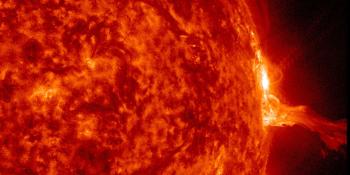Viewing archive of Wednesday, 10 April 2002
Solar activity report
Any mentioned solar flare in this report has a scaling factor applied by the Space Weather Prediction Center (SWPC). Because of the SWPC scaling factor, solar flares are reported as 42% smaller than for the science quality data. The scaling factor has been removed from our archived solar flare data to reflect the true physical units.
Report of Solar-Geophysical Activity 2002 Apr 10 2200 UTCPrepared by the NOAA © SWPC and processed by SpaceWeatherLive.com
Joint USAF/NOAA Report of Solar and Geophysical Activity
SDF Number 100 Issued at 2200Z on 10 Apr 2002IA. Analysis of Solar Active Regions and Activity from 09-2100Z to 10-2100Z
Solar activity was at high levels. An M8.2/1N flare
occurred at 10/1231 UTC from Region 9893(N19W14) characterized by
parallel ribbons and multiple eruptive centers. Associated with
this flare was a Type II radio burst (702 km/s) and a partial halo
CME observed from SOHO/LASCO imagery. Region 9893 has begun to
decay and has simplified to a beta-gamma magnetic configuration.
Region 9899 (N18E22) has increased in magnetic complexity to a
beta-gamma spot and produced an M1.6/1n flare at 10/1907 UTC.
Region 9901(N20W02) has shown growth in spot count and magnetic
complexity. Region 9904 (S16W21) has developed a small delta
configuration in the leader spot. Region 9905 (S17E04) was numbered
today.
IB. Solar Activity Forecast
Solar activity is expected to be
moderate. Region 9893 is in decay phase but still has the potential
for a major flare. Region 9899 and Region 9901 are in a growth
phase and could produce M-class events.
IIA. Geophysical Activity Summary 09-2100Z to 10-2100Z
The geomagnetic field was at quiet levels for most of the day with
one period of unsettled conditions from 15-18Z. The lingering
effects of the high speed stream appear to be ending. Greater than
2 MeV electrons have returned to near background levels after three
days of enhancement.
IIB. Geophysical Activity Forecast
The geomagnetic field is
expected to be quiet to active. There is a chance of increased
geomagnetic activity late on day two due to a CME shock passage. On
day three of the forecast period another CME shock is expected (from
the M8/1N flare on 10/1231 UTC) and geomagnetic activity is expected
to reach unsettled to active conditions. There is a slight chance
of isolated minor storm levels especially at high latitudes.
III. Event Probabilities 11 Apr to 13 Apr
| Class M | 60% | 60% | 60% |
| Class X | 10% | 10% | 10% |
| Proton | 05% | 05% | 05% |
| PCAF | yellow | ||
IV. Penticton 10.7 cm Flux
Observed 10 Apr 194 Predicted 11 Apr-13 Apr 195/190/185 90 Day Mean 10 Apr 203
V. Geomagnetic A Indices
Observed Afr/Ap 09 Apr 002/006 Estimated Afr/Ap 10 Apr 006/008 Predicted Afr/Ap 11 Apr-13 Apr 004/008-008/010-012/015
VI. Geomagnetic Activity Probabilities 11 Apr to 13 Apr
| A. Middle Latitudes | |||
|---|---|---|---|
| Active | 10% | 15% | 20% |
| Minor storm | 01% | 05% | 10% |
| Major-severe storm | 01% | 01% | 05% |
| B. High Latitudes | |||
|---|---|---|---|
| Active | 15% | 15% | 20% |
| Minor storm | 05% | 05% | 10% |
| Major-severe storm | 01% | 01% | 05% |
All times in UTC
Latest news
Latest forum messages
New around here. Carrington and Miyake 3Filaments and prominences 167AR4087 199Line chart of indicators on the auror video, animated graph trace 37Unspecified geomagnetic activity 2503
More topicsSupport SpaceWeatherLive.com!
A lot of people come to SpaceWeatherLive to follow the Sun's activity or if there is aurora to be seen, but with more traffic comes higher server costs. Consider a donation if you enjoy SpaceWeatherLive so we can keep the website online!

Space weather facts
| Last X-flare | 2025/05/14 | X2.7 |
| Last M-flare | 2025/05/15 | M2.1 |
| Last geomagnetic storm | 2025/05/17 | Kp6+ (G2) |
| Spotless days | |
|---|---|
| Last spotless day | 2022/06/08 |
| Monthly mean Sunspot Number | |
|---|---|
| April 2025 | 140.6 +6.4 |
| May 2025 | 69.8 -70.8 |
| Last 30 days | 94.1 -22.3 |


